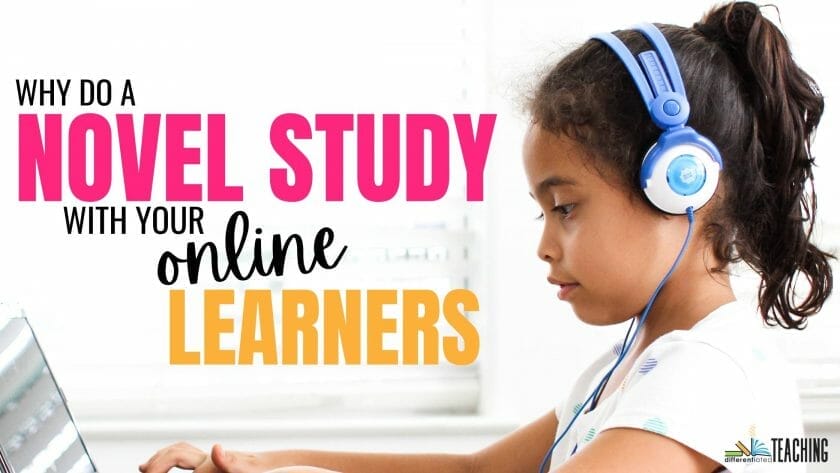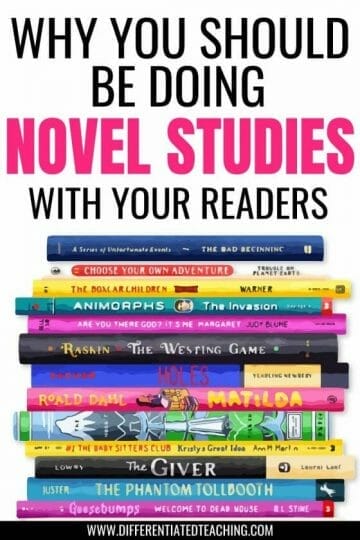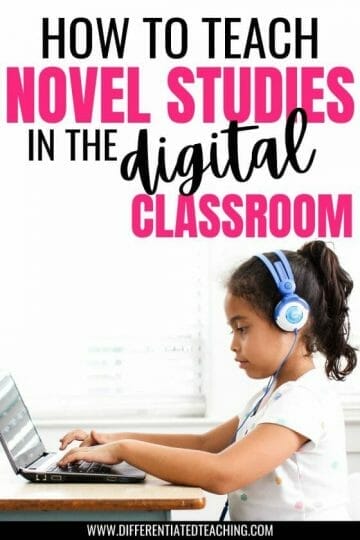The secrets to implementing novel studies in the online classroom
It has been nearly a year since many schools transitioned to remote learning. It felt like being asked to build the plane while in the air for the majority of us. Yet, it is no surprise, teachers have risen to the challenge.
As we reach spring, classes begin to focus on mastering the application of reading comprehension skills. Novel studies, for example, are one popular way to practice real-world application of reading comprehension skills.
But what does this look like if you’re teaching virtually? Let’s dig in and find out.

How to do a novel study with online classes
Planning a novel study can be overwhelming. The idea of adapting your novel unit for your digital classroom only compounds that feeling, especially when you’ve got so much else on your plate.
That’s why I wanted to share some ideas that can help simplify planning and implementation for you and still make it a valuable learning experience for your students.
Why Do a Novel Study?

Many of us are finding ourselves in positions where we’re reinventing the wheel regarding how we implement the curriculum and meet the standards. While it is challenging to take the material we’ve worked hard to master and redefine how we provide instruction, this is also an opportunity to examine new ways of doing things.
In case you’re just thinking about adding novel studies to your instructional repertoire, I want to review a few ideas about why you should consider novel-based activities in the first place.
First, novel units are an opportunity for upper elementary and middle school students to more deeply analyze text.

Up until now, many districts have required the teacher to rely on the short passages and excerpts commonly found in textbooks or basal readers.
While opinions of these materials vary, we can all agree they lack the depth for the characters and plot that one would find in a chapter book.
Introducing the students to classic or more modern texts fosters a deeper understanding of the features of different literary genres and can begin to develop their reading preferences.
Chapter books also help learners develop reading stamina.
They offer opportunities to engage in higher-order thinking skills. Plot and character analysis, for example, boost critical thinking skills and can be emphasized more authentically via novel units. This is because the author is not tied down to a set word count making it easier to add necessary details.
By introducing novels early and often, teachers give their students a more real-world experience for reading than textbooks could ever do.
How do I teach a novel study online?
As with teaching all curriculum, the key is to plan ahead and give adequate time to your novel unit’s creation process.

You’ll also want to be ready for anything that may pop up and complicate matters – which happens all too often in the digital classroom. Trying to wing something like this on the fly is a recipe for disaster.
I’ve created a workbook to help you break down the steps of planning a novel study – whether digital or in-person. I’d love to share it with you free. Just enter your information below.
How to choose the right book when planning a novel study for online learning
You’ve likely already set your goals for reading by the time you’ve decided on doing a novel unit. However, you may not have had a chance to dig into the logistics of how to get things set up in the virtual classroom.

Whether you’re teaching novels in person or online, you’ll want to make sure your choice is a good fit for your students. This means you’ll need to consider:
- Content – is the material appropriate and readable for my learners?
- Connection – will they be able to connect with the characters?
- Copies – do I have access to enough copies (either physical or digital) to allow students to view the text?
Depending on how you’re formatting your digital novel study, you’ll have some wiggle room on these three items. However, since you won’t be there to monitor as closely as you can in the classroom, you’ll want to make sure you don’t pick a book that is too far of a stretch for your readers.
When it comes to copies, you’ve got several options. Of course, these may depend on where you teach and or the needs of your learners, but in theory, you’ve got three choices:
- Provide physical copies of the book using a class set you already have & dropping them off or mailing them to students.
- Provide parents with the link to purchase copies of the text for their learners.
- Use a digital text via a free or paid platform, depending on your school and city resources.
If we look at the research, there is a clear benefit to putting a real book into students’ hands, so if you’ve got that option, I highly recommend going that route.
How to get books for your digital novel unit

If you’re a planner, you can often get a class set of the novel you’re planning to use at great prices. These websites can help you find inexpensive sets of books.
If it is a novel you love, and you know you’ll use it for years to come, it can definitely be worth it to make the small investment.
Alternatively, many campuses have re-allocated some of their budgets to help offset costs like this. Consider checking with your administrator to see if they are willing and able to foot the bill.
However, if you have concerns about getting your books back when the unit is over, one of the other options is likely a better option.
Where can I find free novels online for my book study?
The great news is that finding online texts has grown easier over the last five years.
One advantage of digital reading is that many sites allow for annotation so students can take notes alongside the text. As a teacher, you also have the advantage of not having to worry about lost or damaged books. You also get to avoid the matter of sanitizing them.

Here are a few suggestions for where to find digital novels:
- Epic: Has lots of popular titles & offers audiobook options.
- Scribd: You can find many books here and can get free access for 60 days with this link. There are so many great titles.
- Amazon: They’ve got some great free Kindle titles, or you can get a subscription to Kindle Unlimited for 2 months free.
- Open Library – Like a free digital library. Offers digital checkout.
- Libby – Let’s you borrow e-books and audiobooks from your public library.
I’ve also created a list of websites that offer reading material for kids, including novels. Click here to see all 20 free websites for digital reading.
Tips for planning a novel study for your online class
The planning process is one area that can get sticky, even for seasoned educators. These tips can help make things a little easier for you.

1. Start with the end in mind.
Start off with what you want the students to learn from this. It may be any of these strategies listed below or even all of them.
- Examining a world theme via literature
- Developing comprehension skills
- Explore alternative viewpoints
- Acquiring background knowledge
If you use the planning workbook, I’ve included some space for you to brainstorm your goal. While it may seem trivial, this is important because you want to make sure students are getting the most from your unit.

2. Find ways to amp up the excitement & build background
Just like movie trailers make the viewers excited about watching a film, you must do the same with a novel.
Build up the excitement and get the students enthusiastic about starting this book.
You’ll also want to assess and fill in any essential gaps in background knowledge before reading. For some genres, like historical fiction, this may include helping students understand the historical period where the book takes place.

Short videos can be included to introduce topics, settings, or themes leading up to your unit. However, this is only one of many options.
Here are a few others:
- Consider having students take a stance on a quote from the text.
- Use Google Maps to find the locations of the places discussed in the novel.
- Make it a game by showing pictures or symbols representing the content and seeing if students can put the pieces together.
- Use CommonLit or Listenwise to develop background knowledge and activate schema.
- If you are lucky, there could even be virtual field trips available for some of these locations or on a few of the topics covered in the novel.
In any case, your job here is to be a promoter to win their approval for the upcoming story while filling in any gaps that may prevent them from understanding.
3. Get detailed with your plan for lessons & discussion
You want to make sure you have a clear idea of how you’ll provide instruction and guiding the discussion. You’ll want to consider how you’ll teach mini-lessons and engage students in conversations about the book.

If you’re looking for a way to get more from your time, flipped instruction focusing on comprehension strategies can be ideal. Tools like Loom and Screencastify let you make recordings of your mini-lessons for students to watch before you meet. These are also great because students can rewatch them to review.
When it comes to discussions, you’ll need to choose how they’ll take place before getting into the details.
Will you be meeting synchronously to discuss the reading?
Will students be expected to participate in asynchronous discussions via online platforms?
Depending on what you decide, you’ve got some tools at your disposal. For example, video conferencing can be great for small group discussions. However, it can be challenging for a large class to share this way without using breakout rooms.
Other tech tools like email, chat boards, Google Docs, and Google Classroom are alternatives for one-on-one discussions or monitoring participation and understanding in larger groups.
Regardless of what you choose, be sure you consider your role in the discussion process and how you’ll introduce the procedures and expectations before you get started.
Here are some guiding questions for that process:
- What are the expectations for active listening and responding?
- If doing groups, how will I monitor?
- What are the expectations for interaction/participation?
- How will you interact with the groups?
- What is your role as the teacher, and what can students expect from you?
Initially, you’ll likely need to guide students more. However, the goal should be to transfer ownership of discussions to the students.
4. Decide how you’ll monitor student understanding & grade the novel study
You’ll also need to plan how you’ll monitor understanding and grade your students during your digital novel study.
You might be wondering, how do I grade a novel study?

Having students complete a structured response to literature is a popular option.
Google Slides are great for this, as students can get the question and type their response directly into the slide. You can also embed video or audio reminders for the key expectations right into the slides.
Assessment works best when you create a rubric. This lets students know exactly what is expected for each lesson and how their responses will be graded. They also provide a clear-cut way to show parents their child’s strengths and areas for growth.
If you’re using Google Classroom or Schoology, you can embed those right into the assignment.
You can also consider adding a final project. Novel studies are perfect for creative teachers because you can develop various tasks and give students a choice.
The most important thing is to make sure that the projects are engaging and connected to skills they’ll actually use.
For example, students may make a slideshow or create a podcast episode about the book. Both of these require real-world skills that are highly desirable in the workplace.
Alternatively, you might have students write the author to share feedback and ask clarifying questions if they are still alive.
Regardless of what you pick, please don’t just test kids on whether they can regurgitate the plot. There is nothing that kills the joy of reading faster.
Don’t worry! It gets easier.
If this is your first time doing a novel study through remote learning, it may seem stressful at first.
But just like with everything in life, the more you do it, the better you will get.
And look at the positives.
A novel study could take three weeks to complete so you won’t need to dedicate as much time to planning once you’ve got your unit outlined.
You can tie it into other subject areas without being tethered to a textbook – instant cross-curricular learning!
Ready to get started?
Grab the free planning roadmap and get planning your novel study for online learning today!






